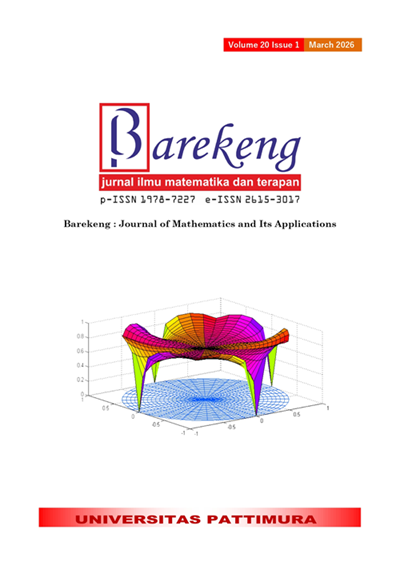FORECASTING STATIONARY CLIMATE DATA USING AUTOREGRESSIVE MODELS AND HIGH-ORDER FUZZY
Abstract
Forecasting is essential for improving aviation safety, with air humidity being a critical factor influenced by air temperature. This study analyzes daily humidity data from I Gusti Ngurah Rai Airport, one of Indonesia’s busiest air stations, using two time series modeling approaches: Autoregressive (AR) and high-order fuzzy modeling. The objective is to evaluate and compare their forecasting accuracy. Historical daily data from the Meteorology, Climatology, and Geophysics Agency of Indonesia were used to build the forecasting models. The optimal linear AR model served as the foundation for constructing the AR high-order fuzzy model, which incorporates linguistic rules to capture nonlinear patterns. Both models were implemented and evaluated using the Mean Squared Error (MSE) metric. Results show that the AR(2) model outperforms the AR high-order fuzzy model, achieving a lower MSE of 13.23. This suggests that the AR(2) model provides more accurate humidity forecasts over the observed period. These findings offer practical insights for policymakers and decision-makers in forecasting daily humidity levels and supporting aviation operations. While the study confirms the effectiveness of traditional AR modeling, it also highlights limitations of the fuzzy approach, particularly its sensitivity to parameter tuning and data sparsity. The integration of high-order fuzzy modeling represents a novel contribution to this domain, though further refinement is needed to enhance its forecasting performance.
Downloads
References
N. W. N. S. Wardani and I. G. A. Wesnawa, “POTENSI EKOWISATA KAMPOENG KEPITING DI DESA TUBAN, KECAMATAN KUTA, KABUPATEN BADUNG,” Jurnal Pendidikan Geografi Undiksha, vol. 6, no. 1, pp. 1–12, Mar. 2018, doi: https://doi.org/10.23887/jjpg.v6i1.20678.
R. G. Alfitri and S. W. Purnami, “PERAMALAN TEMPERATUR RATA-RATA DAN KELEMBABAN RATA-RATA HARIAN KABUPATEN SERAM BAGIAN TIMUR MENGGUNAKAN ARIMA BOX-JENKINS,” Jurnal Inferensi, pp. 1–10, 2021.
M. Lutfi, “ANALISIS PENGARUH FAKTOR IKLIM SETEMPAT (KLIMATOLOGI) TERHADAP PENGEMBANGAN LANDASAN PACU (RUNWAY) PADA BANDAR UDARA,” Jurnal Komposit, vol. 1, no. 2, pp. 13–20, 2017.
I. R. Maharsi, Moch. A. Mukid, and Y. Wilandari, “PERAMALAN JUMLAH KECELAKAAN DI KOTA SEMARANG TAHUN 2017 MENGGUNAKAN METODE RUNTUN WAKTU (STUDI KASUS : DATA JUMLAH KECELAKAAN LALU LINTAS DI KOTA SEMARANG PERIODE JANUARI 2012 – DESEMBER 2016),” Jurnal Gaussian, vol. 6, no. 3, pp. 355–364, Jan. 2018, doi: doi.org/10.14710/j.gauss.6.3.355-364.
M. B. Pamungkas, “APLIKASI METODE ARIMA BOX-JENKINS UNTUK MERAMALKAN KASUS DBD DI PROVINSI JAWA TIMUR,” The Indonesian Journal of Public Health, vol. 13, no. 2, p. 183, Feb. 2019, doi: 10.20473/ijph.v13i2.2018.183-196.
S.-M. Chen and Y.-C. Chang, “MULTI-VARIABLE FUZZY FORECASTING BASED ON FUZZY CLUSTERING AND FUZZY RULE INTERPOLATION TECHNIQUES,” Inf Sci (N Y), vol. 180, no. 24, pp. 4772–4783, Dec. 2010, doi: https://doi.org/10.1016/j.ins.2010.08.026.
Q. Cai, D. Zhang, W. Zheng, and S. C. H. Leung, “A NEW FUZZY TIME SERIES FORECASTING MODEL COMBINED WITH ANT COLONY OPTIMIZATION AND AUTO-REGRESSION,” Knowl Based Syst, vol. 74, pp. 61–68, Jan. 2015, doi: https://doi.org/10.1016/j.knosys.2014.11.003.
Shyi-Ming Chen and Shen-Wen Chen, “FUZZY FORECASTING BASED ON TWO-FACTORS SECOND-ORDER FUZZY-TREND LOGICAL RELATIONSHIP GROUPS AND THE PROBABILITIES OF TRENDS OF FUZZY LOGICAL RELATIONSHIPS,” IEEE Trans Cybern, vol. 45, no. 3, pp. 391–403, Mar. 2015, doi: https://doi.org/10.1109/TCYB.2014.2326888.
O. Cagcag Yolcu, U. Yolcu, E. Egrioglu, and C. H. Aladag, “HIGH ORDER FUZZY TIME SERIES FORECASTING METHOD BASED ON AN INTERSECTION OPERATION,” Appl Math Model, vol. 40, no. 19–20, pp. 8750–8765, Oct. 2016, doi: https://doi.org/10.1016/j.apm.2016.05.012
F. Ye, L. Zhang, D. Zhang, H. Fujita, and Z. Gong, “A NOVEL FORECASTING METHOD BASED ON MULTI-ORDER FUZZY TIME SERIES AND TECHNICAL ANALYSIS,” Inf Sci (N Y), vol. 367–368, pp. 41–57, Nov. 2016, doi: https://doi.org/10.1016/j.ins.2016.05.038.
S.-M. Chen and W.-S. Jian, “FUZZY FORECASTING BASED ON TWO-FACTORS SECOND-ORDER FUZZY-TREND LOGICAL RELATIONSHIP GROUPS, SIMILARITY MEASURES AND PSO TECHNIQUES,” Inf Sci (N Y), vol. 391–392, pp. 65–79, Jun. 2017, doi: https://doi.org/10.1016/j.ins.2016.11.004.
W. Sulandari and Y. Yudhanto, “FORECASTING TREND DATA USING A HYBRID SIMPLE MOVING AVERAGE-WEIGHTED FUZZY TIME SERIES MODEL,” in 2015 International Conference on Science in Information Technology (ICSITech), IEEE, Oct. 2015, pp. 303–308. doi: https://doi.org/10.1109/ICSITech.2015.7407822.
A. J. F. Zamelina, S. Astutik, R. Fitriani, A. A. R. Fernandes, and L. Ramifidisoa, “ENHANCING WEIGHTED FUZZY TIME SERIES FORECASTING THROUGH PARTICLE SWARM OPTIMIZATION,” Barekeng, vol. 18, no. 4, pp. 2675–2684, Dec. 2024, doi: https://doi.org/10.30598/barekengvol18iss4pp2675-2684.
Z. Liu and T. Zhang, “AN IMPROVED ARMA(1, 1) TYPE FUZZY TIME SERIES APPLIED IN PREDICTING DISORDERING,” Numerical Algebra, Control & Optimization, vol. 10, no. 3, p. 355, 2020, doi: https://doi.org/10.3934/naco.2020007 .
C. Kocak, “ARMA(P,Q) TYPE HIGH ORDER FUZZY TIME SERIES FORECAST METHOD BASED ON FUZZY LOGIC RELATIONS,” Appl Soft Comput, vol. 58, pp. 92–103, Sep. 2017, doi: https://doi.org/10.1016/j.asoc.2017.04.021.
E. Egrioglu, U. Yolcu, C. H. Aladag, and C. Kocak, “AN ARMA TYPE FUZZY TIME SERIES FORECASTING METHOD BASED ON PARTICLE SWARM OPTIMIZATION,” Math Probl Eng, vol. 2013, pp. 1–12, 2013, doi: https://doi.org/10.1155/2013/935815.
C. Kocak, “FIRST-ORDER ARMA TYPE FUZZY TIME SERIES METHOD BASED ON FUZZY LOGIC RELATION TABLES,” Math Probl Eng, vol. 2013, pp. 1–12, 2013, doi: https://doi.org/10.1155/2013/769125.
C. Kocak, E. Egrioglu, and U. Yolcu, “RECURRENT TYPE FUZZY TIME SERIES FORECASTING METHOD BASED ON ARTIFICIAL NEURAL NETWORKS,” American Journal of Operational Research, vol. 5, no. 5, pp. 111–124, 2015, doi: 10.5923/j.ajor.20150505.02.
C. Kocak, “A NEW HIGH ORDER FUZZY ARMA TIME SERIES FORECASTING METHOD BY USING NEURAL NETWORKS TO DEFINE FUZZY RELATIONS,” Math Probl Eng, vol. 2015, pp. 1–14, 2015, doi: https://doi.org/10.1155/2015/128097.
S. Makridakis, METODE DAN APLIKASI PERAMALAN, Jilid 1 Edisi Kedua. Jakarta: Erlangga, 1999.
W. W. S. Wei, TIME SERIES ANALYSIS: UNIVARIATE AND MULTIVARIATE METHODS, 2nd ed. New Jersey: Pearson Addison Wesley, 2006.
T. Lee, “WILD BOOTSTRAP LJUNG–BOX TEST FOR RESIDUALS OF ARMA MODELS ROBUST TO VARIANCE CHANGE,” J Korean Stat Soc, vol. 51, no. 4, pp. 1005–1020, Dec. 2022, doi: https://doi.org/10.1007/s42952-022-00172-6.
M. L. Tauryawati and M. I. Irawan, “PERBANDINGAN METODE FUZZY TIME SERIES CHENG DAN METODE BOX-JENKINS UNTUK MEMPREDIKSI IHSG,” Jurnal Sains dan Seni Pomits, vol. 3, no. 2, pp. 34–39, 2014.
W. Sulandari, Suhoartono, dan Y. Yudhanto. APLIKASI FUZZY PADA PEMODELAN RUNTUN WAKTU. Bandung: Khazanah, 2020. Intelektual.
P. C. B. Phillips and P. Perron, “TESTING FOR A UNIT ROOT IN TIME SERIES REGRESSION,” Biometrika, vol. 75, no. 2, pp. 335–346, 1988, doi: https://doi.org/10.1093/biomet/75.2.335.
S. Suryono, R. Saputra, B. Surarso, and H. Sukri, “WEB-BASED FUZZY TIME SERIES FOR ENVIRONMENTAL TEMPERATURE AND RELATIVE HUMIDITY PREDICTION,” in 2017 IEEE International Conference on Communication, Networks and Satellite (Comnetsat), IEEE, Oct. 2017, pp. 36–41. doi: https://doi.org/10.1109/COMNETSAT.2017.8263570.
Copyright (c) 2025 Alfien Diva Kayyisa, Winita Sulandari, Isnandar Slamet

This work is licensed under a Creative Commons Attribution-ShareAlike 4.0 International License.
Authors who publish with this Journal agree to the following terms:
- Author retain copyright and grant the journal right of first publication with the work simultaneously licensed under a creative commons attribution license that allow others to share the work within an acknowledgement of the work’s authorship and initial publication of this journal.
- Authors are able to enter into separate, additional contractual arrangement for the non-exclusive distribution of the journal’s published version of the work (e.g. acknowledgement of its initial publication in this journal).
- Authors are permitted and encouraged to post their work online (e.g. in institutional repositories or on their websites) prior to and during the submission process, as it can lead to productive exchanges, as well as earlier and greater citation of published works.






1.gif)



